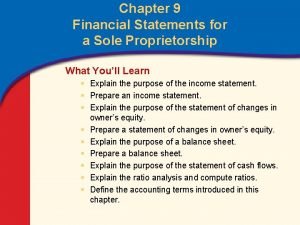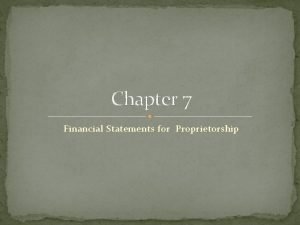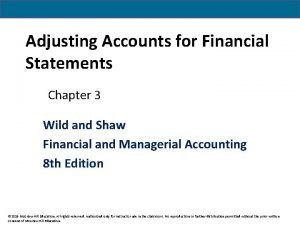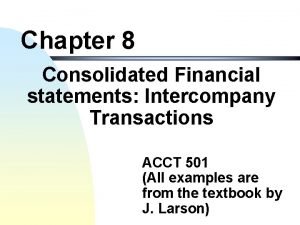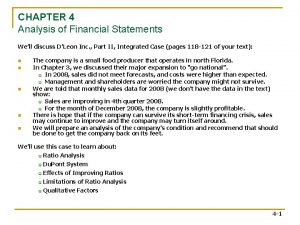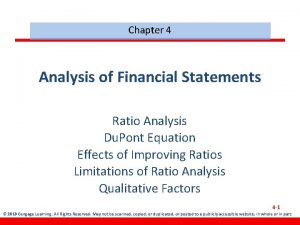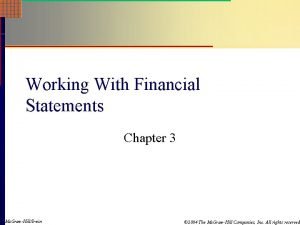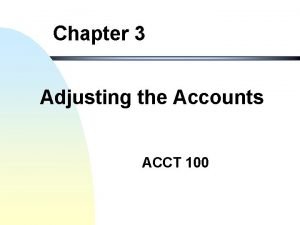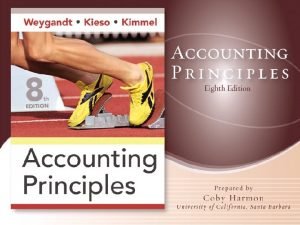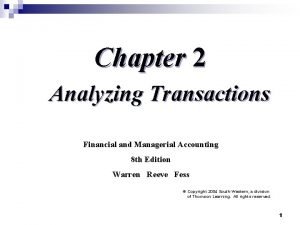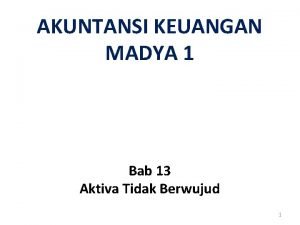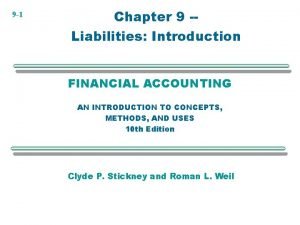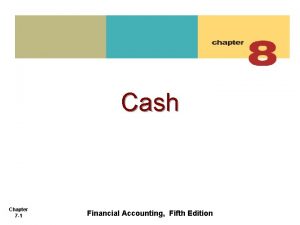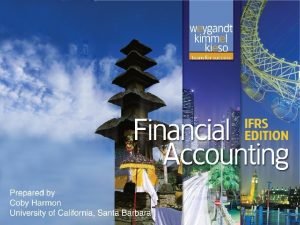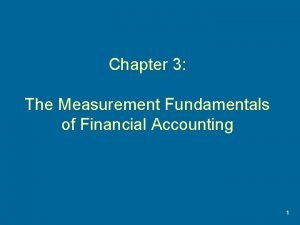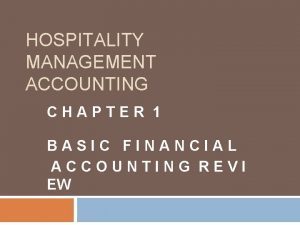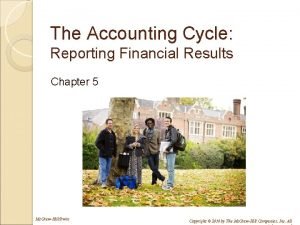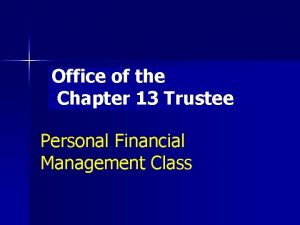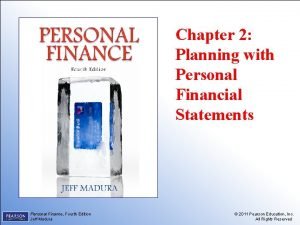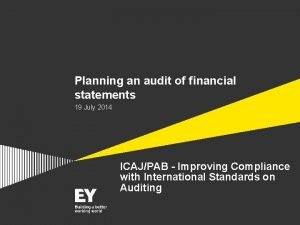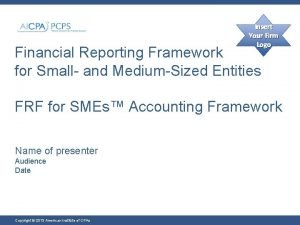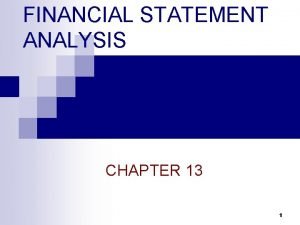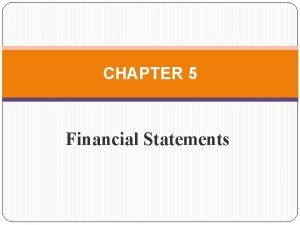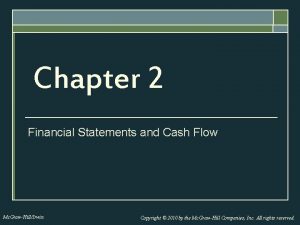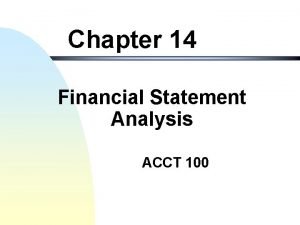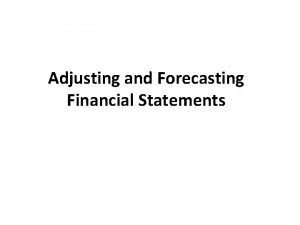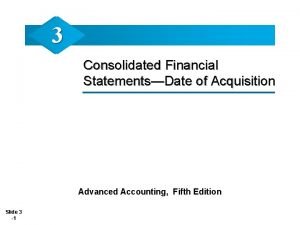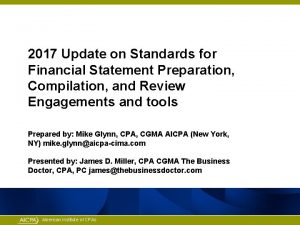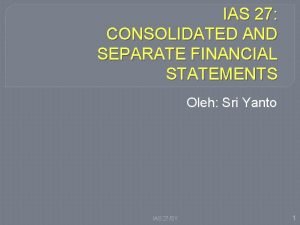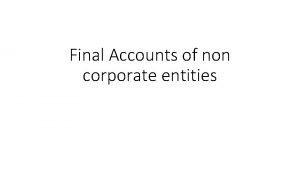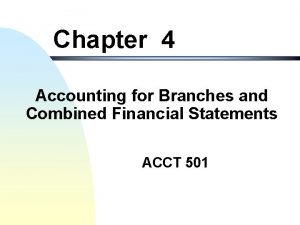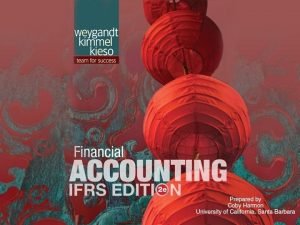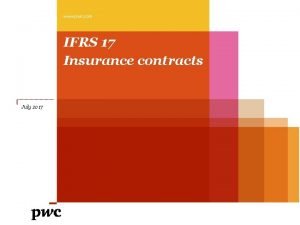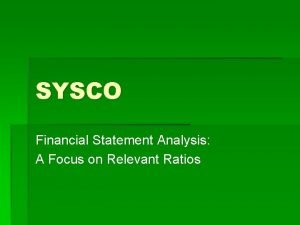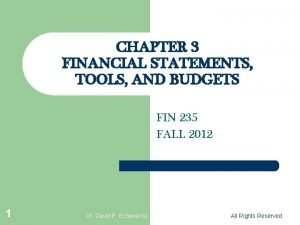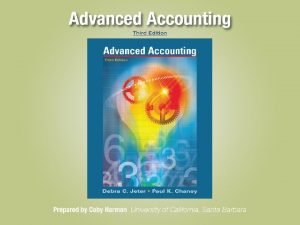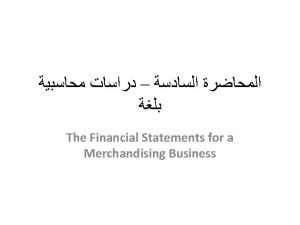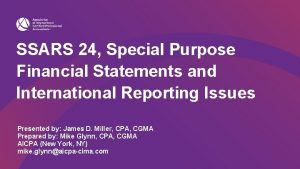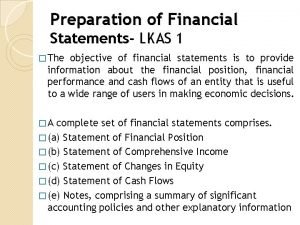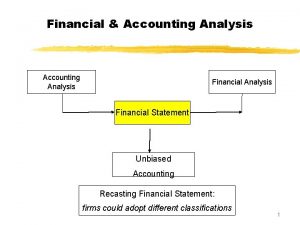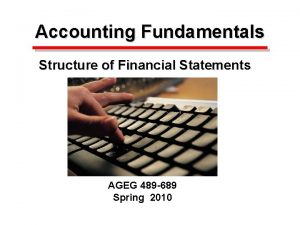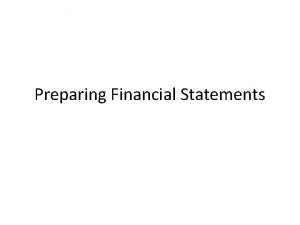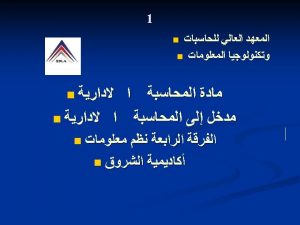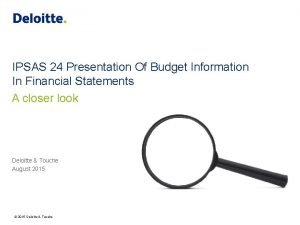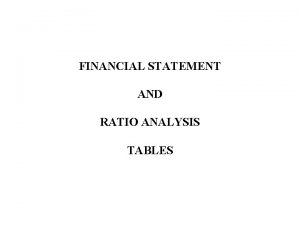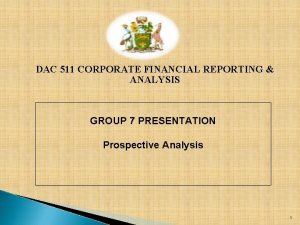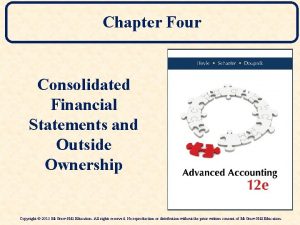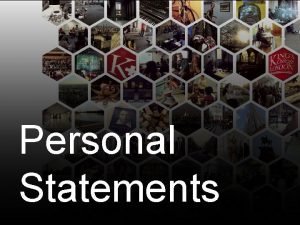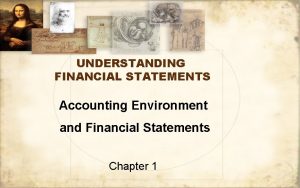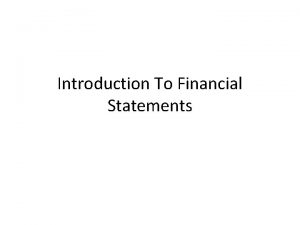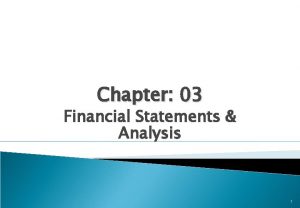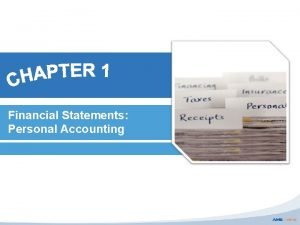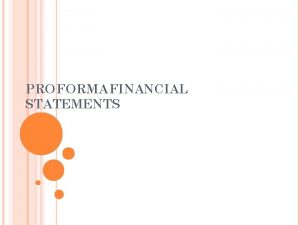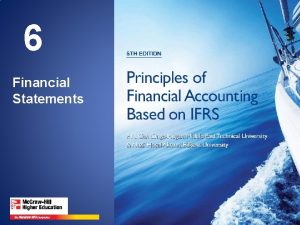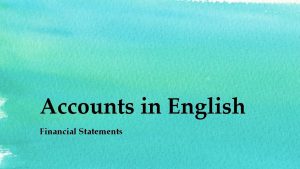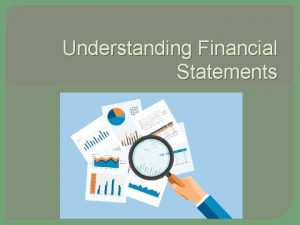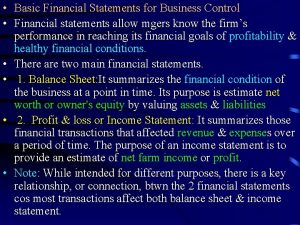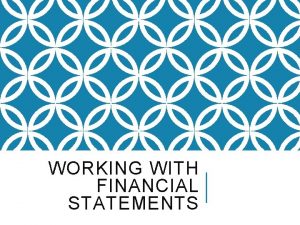CHAPTER 1 FINANCIAL STATEMENTS PERSONAL ACCOUNTING CHAPTER 1


































































- Slides: 66

CHAPTER 1 FINANCIAL STATEMENTS: PERSONAL ACCOUNTING

CHAPTER 1 The Purpose Of Accounting The Balance Sheet The Income Statement Accounting Periods The Accounting Equation Accrual-based Accounting Borrowing Money And Repaying Debt Buying And Selling Assets Prepaid Expenses Capital T-account Transactions In Summary Exercise Copyright © 2016 AME Learning Inc. 2

The Purpose of Accounting is a system to identify , measure and communicate all the financial activities of an individual or a business. Copyright © 2016 AME Learning Inc. Accounting help you a great deal, because a working knowledge of accounting is desirable for virtually every field of endeavor. While It is important to maintain records of activities that increase or decrease your net worth. 3

The Purpose of Accounting The two basic elements of a business are what it owns and what it owes. Assets are the resources a business owns. Claims of those to whom the company owes money (creditors) are called liabilities. Example Assets (what we own) Copyright © 2016 AME Learning Inc. Liabilities (what we owe) 4

Self Study Question What is the purpose of accounting? a. Practice accountability b. Measure and communicate financial activities of an individual or business c. Improve financial discipline d. Improve logical thinking PREPARED BY AME LEARNING Copyright © 2016 AME Learning Inc. 55

CHAPTER 1 The Purpose Of Accounting The Balance Sheet The Income Statement Accounting Periods The Accounting Equation Accrual-based Accounting Borrowing Money And Repaying Debt Buying And Selling Assets Prepaid Expenses Capital T-account Transactions In Summary Exercise Copyright © 2016 AME Learning Inc. 6

The Balance Sheet The balance sheet is a permanent document that is used to record what you own (assets), what you owe (liabilities) and what you are worth (net worth) on a specific date. Assets-All that you OWN Liabilities-All that you OWE Assets Liabili ties Value of Assets = $75, 000 Copyright © 2016 AME Learning Inc. Value of Liabilities = $50, 000 Net worth = $25, 000 7

The Balance Sheet OWE OWN Copyright © 2016 AME Learning Inc. 8

The Balance Sheet Sample Personal Balance Sheet Copyright © 2016 AME Learning Inc. 9

The Balance Sheet Sample Personal Balance Sheet Net Worth is equal to assets minus liabilities. A large amount of cash balance does not necessarily imply a high net worth. Similarly, a low cash balance does not necessary imply a low net worth. Shown below are two personal balance sheets that illustrate this concept. Copyright © 2016 AME Learning Inc. 10

Self Study Question What is the role of the balance sheet? a. Record Expenses b. Record what we earn VS what we owe c. Record what we own VS what we owe d. Record all financial transactions PREPARED BY AME LEARNING Copyright © 2016 AME Learning Inc. 11 11

CHAPTER 1 The Purpose Of Accounting The Balance Sheet The Income Statement Accounting Periods The Accounting Equation Accrual-based Accounting Borrowing Money And Repaying Debt Buying And Selling Assets Prepaid Expenses Capital T-account Transactions In Summary Exercise Copyright © 2016 AME Learning Inc. 12

The Income Statement E. g. Salary earned (increases net worth) Costs of day-to-day activities (decreases net worth) Copyright © 2016 AME Learning Inc. 13

The Income Statement Revenues and Expenses The income statement reports the revenues and expenses for a specific period of time. Revenue is an increase to net worth caused by providing goods or services in exchange for an asset, usually cash. Expenses are costs and a decrease to net worth caused by day-to-day activities. Net income results when revenues exceed expenses. A net loss occurs when expenses exceed revenues. Copyright © 2016 AME Learning Inc. 14

Self Study Question What is the role of the income statement? a. Record only cash sales and expenses b. Record what we own VS what we owe c. Record revenues and expenses d. Record all financial transactions PREPARED BY AME LEARNING Copyright © 2016 AME Learning Inc. 15 15

CHAPTER 1 The Purpose Of Accounting The Balance Sheet The Income Statement Accounting Periods The Accounting Equation Accrual-based Accounting Borrowing Money And Repaying Debt Buying And Selling Assets Prepaid Expenses Capital T-account Transactions In Summary Exercise Copyright © 2016 AME Learning Inc. 16

Accounting Period An accounting period is the time frame in which the financial statements are prepared and can be one year, six months or one month. Changes to net worth are tracked for separate periods called accounting periods. Some advantages of using monthly accounting periods for your personal financial statements include ü Tracking regular monthly living expenses (e. g. rent, cell phone) ü Frequently assessing realistic expectations ü Controlling errors effectively Copyright © 2016 AME Learning Inc. 17

Self Study Question What happens at the end of an accounting period? a. Balance sheet accounts are closed b. Income statement accounts are closed c. All accounts are closed d. None of the accounts are closed PREPARED BY AME LEARNING Copyright © 2016 AME Learning Inc. 18 18

Solution b. Income statement accounts are closed. Why? üIncome statement consists of temporary accounts. üIncome statement is only required during a period to track the changes to net worth (revenue and expenses). üA new period commences with a fresh income statement. Copyright © 2016 AME Learning Inc. 19

CHAPTER 1 The Purpose Of Accounting The Balance Sheet The Income Statement Accounting Periods The Accounting Equation Accrual-based Accounting Borrowing Money And Repaying Debt Buying And Selling Assets Prepaid Expenses Capital T-account Transactions In Summary Exercise Copyright © 2016 AME Learning Inc. 20

The Accounting Equation Assets Worth = Liabilities + Net This relationship is the basic accounting equation. Assets must equal the sum of liabilities and owner’s equity. Liabilities appear before owner’s equity in the basic accounting equation because they are paid first if a business is liquidated. The accounting equation applies to all economic entities regardless of size, nature of business, or form of business organization. Assumptions: üEach transaction has at least two entries. üThe logic is similar to Newton’s Third Law (for every action, there is an equal and opposite reaction). üIn the absence of a logical opposite entry, the balance sheet will not balance. Copyright © 2016 AME Learning Inc. 21

The Accounting Equation Imagine the accounting equation as a scale with each side in balance; the left side of the scale would include assets and the right side would include liabilities and net worth. The scale must always be in balance. Copyright © 2016 AME Learning Inc. 22

The Accounting Equation Imagine the accounting equation as a scale with each side in balance; the left side of the scale would include assets and the right side would include liabilities and net worth. The scale must always be in balance. Copyright © 2016 AME Learning Inc. 23

The Accounting Equation Imagine the accounting equation as a scale with each side in balance; the left side of the scale would include assets and the right side would include liabilities and net worth. The scale must always be in balance. Copyright © 2016 AME Learning Inc. 24

The Accounting Equation Introduction to T-Accounts To record analyze transactions, and to keep the accounting equation balanced, we use T-accounts. The term T-account describes the appearance of the bookkeeping entries. Increases and decreases to each account are recorded here. The category of the account (asset, liability, net worth, revenue or expense) will determine which side of the T-account is the increase and which side is the decrease. Sample Figure : Copyright © 2016 AME Learning Inc. 25

The Accounting Equation Get Started: T-Accounts The balance of a T-account at the end of the period is simply the difference between all the increases and decreases. Record the opening balance of the account in the appropriate side. For Instance : Cash has an opening balance of $1000. Copyright © 2016 AME Learning Inc. 26

Self Study Question In year 2016, your opening net worth was $14, 000 and total capital items was $7, 000. Your personal income statement for 2016 showed a deficit of $3, 000. What is your net worth as at December 31, 2016? a. $18, 000 b. $21, 000 c. $24, 000 d. $17, 000 PREPARED BY AME LEARNING Copyright © 2016 AME Learning Inc. 27 27

CHAPTER 1 The Purpose Of Accounting The Balance Sheet The Income Statement Accounting Periods The Accounting Equation Accrual-based Accounting Borrowing Money And Repaying Debt Buying And Selling Assets Prepaid Expenses Capital T-account Transactions In Summary Exercise Copyright © 2016 AME Learning Inc. 28

Accrual Based Accounting Accrual-based accounting means that revenue (an increase to net worth) and expenses (a decrease to net worth) are recorded in the period in which they occur, regardless of when cash payment is received or paid. Assume that you have $1, 000 of cash and net worth of $1, 000. If you pay for a $300 expense with cash, your cash and your net worth will decrease by $300 If instead you receive a phone bill for $300 to be paid next month, there would be no change in cash in the current month. However, the phone debt (or unpaid accounts) would increase by $300 and net worth would decrease by $300. Copyright © 2016 AME Learning Inc. 29

Accrual Based Accounting Cash Flow Vs. Accruals 1 Cash flow relates to cash flowing into and out of the bank account, which is not necessarily directly connected to net worth. 2 Accruals relate to net worth, which does not necessarily connect to cash flow. Copyright © 2016 AME Learning Inc. 30

Accrual Based Accounting Cash-Based vs. Accrual-Based Accounting Under the Cash-Based Accounting , revenues and expenses are reported in the income statement in the period in which cash is received or paid. For example, fees are recorded when cash is received from clients, and wages are recorded when cash is paid to employees. The net income (or net loss) is the difference between the cash receipts (revenues) and the cash payments (expenses). Under the Accrual-Based Accounting , revenues are reported in the income statement in the period in which they are earned. For example, revenue is reported when the services are provided to customers. Copyright © 2016 AME Learning Inc. 31

Accrual Based Accounting Example Suppose that you deposit salary of $3, 000 in January, but choose to charge all $2, 000 worth of expenses to your credit card, which is to be paid in February. When you use cash-based accounting, your net worth appears to be $3, 000 in January, since no cash is used to pay your expenses. Copyright © 2016 AME Learning Inc. 32

Accrual Based Accounting Example If you are using accrual-based accounting , you need to recognize the expense in January, the month in which it was actually incurred. The income statement for the month of January shows that you have matched the revenue of $3, 000 (an increase in net worth) to the expenses in January of $2, 000 (a decrease in net worth), resulting in an overall increase in net worth of $1, 000. Cash remains at $3, 000 because you have not spent any of it yet. Copyright © 2016 AME Learning Inc. 33

Accrual Based Accounting Example 1. Earn and deposit $5, 000 in salary. Cash increases by $5, 000 which increases the total assets in the accounting equation. 2. Pay $1, 000 in cash for food expenses. Cash decreases by $1, 000 which decreases assets. 3. Record a $500 credit card bill for gasoline expenses (due in one month). Cash is not affected; however, you have a debt which must be paid next month. 4. Record a $1, 500 credit card bill for entertainment expenses. Debt increases which increases the liabilities. Copyright © 2016 AME Learning Inc. 34

Self Study Question If you record a $500 credit card bill for gas expenses (due in one month), what is the effect on net worth? a. Stays the same b. Increases by $500 c. Decreases by $500 d. Not enough information is provided PREPARED BY AME LEARNING Copyright © 2016 AME Learning Inc. 35 35

CHAPTER 1 The Purpose Of Accounting The Balance Sheet The Income Statement Accounting Periods The Accounting Equation Accrual-based Accounting Borrowing Money And Repaying Debt Buying And Selling Assets Prepaid Expenses Capital T-account Transactions In Summary Exercise Copyright © 2016 AME Learning Inc. 36

Borrowing Money And Repaying Debt When you borrow money, you increase your assets and your debts. Net worth is not affected. Copyright © 2016 AME Learning Inc. When you pay your debts (principal), you decrease your assets and your debts. Again, net worth is not affected. 37

Borrowing Money And Repaying Debt When you borrow money, you increase your assets and your debts. Net worth is not affected. When you pay your debts (principal), you decrease your assets and your debts. Again, net worth is not affected. Example Borrow $100 from a friend: you have more cash, but your net worth does not change. Copyright © 2016 AME Learning Inc. Repay your friend: you have less cash, but your net worth still does not change. 38

Self Study Question What is the effect on net worth when borrowing money? a. Net worth increases b. Net worth decreases c. Net worth stays the same d. Net worth will change only when you repay the loan PREPARED BY AME LEARNING Copyright © 2016 AME Learning Inc. 39 39

Solution c. Net worth stays the same. When borrowing cash you are: üCash flow richer. üNot net worth richer. Copyright © 2016 AME Learning Inc. 40

Self Study Question Paying the interest portion of a loan you borrowed: a. Reduces net worth b. Increases net worth c. Has nothing to do with net worth d. Could increase or decrease net worth PREPARED BY AME LEARNING Copyright © 2016 AME Learning Inc. 41 41

Solution a. Reduces net worth. Interest expense will decrease net worth because cash will be used to pay the expense without an asset replacement or debt reduction. An expense means a reduction to net worth. [ DECREASES] Copyright © 2016 AME Learning Inc. 42

CHAPTER 1 The Purpose Of Accounting The Balance Sheet The Income Statement Accounting Periods The Accounting Equation Accrual-based Accounting Borrowing Money And Repaying Debt Buying And Selling Assets Prepaid Expenses Capital T-account Transactions In Summary Exercise Copyright © 2016 AME Learning Inc. 43

Buying and Selling Assets Buying or selling assets (according to the value stated in the balance sheet) has no impact on net worth. Buying a car Selling a car No Impact Copyright © 2016 AME Learning Inc. 44

Buying and Selling Assets Example You purchase a new car for $10, 000; pay $3, 000 cash and take a loan from the bank for the remaining $7, 000. The cash used to purchase the car is just an exchange of one asset for another (cash for the car), so there is no change in net worth. The loan is borrowed to pay for the car, so the liability increases as does the asset (car). Again there is no change in net worth. Affects on the account Copyright © 2016 AME Learning Inc. 45

Self Study Question Suppose you bought furniture worth $6, 000 on June 1, but didn’t pay until July 1. What happened to your net worth? a. Net worth reduced by $6, 000 on June 1 b. Net worth reduced by $6, 000 on July 1 c. There’s no change to net worth d. Net worth increased by $6, 000 on June 1 PREPARED BY AME LEARNING Copyright © 2016 AME Learning Inc. 46 46

CHAPTER 1 The Purpose Of Accounting The Balance Sheet The Income Statement Accounting Periods The Accounting Equation Accrual-based Accounting Borrowing Money And Repaying Debt Buying And Selling Assets Prepaid Expenses Capital T-account Transactions In Summary Exercise Copyright © 2016 AME Learning Inc. 47

Prepaid Expenses A prepaid expense occurs when you pay cash for an expense (like insurance) before you use it. Prepaid expenses arise when expenses are paid for in advance. Insurance and rent are common examples. These prepayments are not considered expenses at the time they are paid because the services have not yet been provided. Example Just as you might pay for your car insurance six months in advance, companies will pay in advance for some items that cover more than one period. Because accrual accounting requires that expenses are recognized only in the period in which they are incurred, these prepayments are recorded as assets called prepaid expenses. Copyright © 2016 AME Learning Inc. 48

Prepaid Expenses Example ü You paid $1, 200 for insurance coverage for the coming year. ü One month of insurance coverage has been used up Copyright © 2016 AME Learning Inc. 49

Prepaid Expenses Example Assume that you hire a gardening service that costs $600 per year ($50 per month). The service provider requests that you prepay the full $600 in January. You have paid the $600 in advance but the service provider owes you the service which you will receive in the future. As a result, this payment is considered an asset (which is a prepaid expense). There is no expense (i. e. a decrease in net worth) until the service is provided. Copyright © 2016 AME Learning Inc. 50

Prepaid Expenses Example Assume that you hire a gardening service that costs $600 per year ($50 per month). The service provider requests that you prepay the full $600 in January. At the end of the first month, have you used up any of the service? An increase in expenses relates to a decrease in net worth. Cash does not have to be involved to increase an expense and decrease net worth. Copyright © 2016 AME Learning Inc. 51

Prepaid Expenses According to accrual-based accounting, expenses are always recorded when they are incurred. This has nothing to do with when the cash payment is made. If we assume an expense is $100, there are three possible timings the payment can be made in relation to the expense being incurred. 1. Pay before and recognize the expense when it is incurred (prepaid expense). 2. Pay as the expense is incurred (cash). 3. Pay after the expense is incurred (unpaid account). Copyright © 2016 AME Learning Inc. 52

Self Study Question Accounting for prepaid expenses is an application of: a. Cash flow accounting b. Accrual accounting c. Accounting for debt d. None of the above PREPARED BY AME LEARNING Copyright © 2016 AME Learning Inc. 53 53

CHAPTER 1 The Purpose Of Accounting The Balance Sheet The Income Statement Accounting Periods The Accounting Equation Accrual-based Accounting Borrowing Money And Repaying Debt Buying And Selling Assets Prepaid Expenses Capital T-account Transactions In Summary Exercise Copyright © 2016 AME Learning Inc. 54

Capital is any transaction that increases your net worth which is not considered revenue. At the end of the period, the accounting equation must still balance, so that assets must equal liabilities plus the ending net worth. Example Receiving a gift or winning a lottery is not revenue, but is considered capital. Ending Net Worth (Deficit) Copyright © 2016 AME Learning Inc. = Beginning Net Worth + Capital + Surplus 55

Self Study Question Which of the following is not considered capital? a. Monthly salary b. Gifts from parents c. Lottery winnings d. All of the above PREPARED BY AME LEARNING Copyright © 2016 AME Learning Inc. 56 56

CHAPTER 1 The Purpose Of Accounting The Balance Sheet The Income Statement Accounting Periods The Accounting Equation Accrual-based Accounting Borrowing Money And Repaying Debt Buying And Selling Assets Prepaid Expenses Capital T-account Transactions In Summary Exercise Copyright © 2016 AME Learning Inc. 57

T-Account Transactions T-account is a graphic representation of a general ledger account. Debit (increase) entries are depicted to the left of the "T" and credits (decrease) are shown to the right of the "T". The list of transactions is numbered and will be numbered in the T-accounts to help keep track of the transactions. Recall that the accounting equation must balance, so every transaction will affect at least two accounts. Copyright © 2016 AME Learning Inc. 58

T-Account Transactions The Process 1 If applicable, enter the opening balances in the appropriate T-account. Then check that the accounting equation is in balance before you begin entering transactions. 2 Enter both sides of the transaction in the correct account in the balance sheet and/or income statement. Be sure to record the transaction number so that you may check your work. 3 Calculate the totals of the T-accounts on the income statement and calculate the surplus or deficit. A surplus will increase net worth and a deficit will decrease net worth. 4 Calculate the totals of the T-accounts on the balance sheet and complete the accounting equation at the bottom of the balance sheet to check that it balances. Copyright © 2016 AME Learning Inc. 59

Self Study Question How should receiving a loan from the bank be recorded on Cash and Bank Loan Taccounts? a. Right side of the Cash T-account and left side of the Bank Loan T-account b. Left side of the Cash T-account and right side of the Bank Loan T-account c. Left side of the Cash T-account and left side of the Bank Loan T-account d. Right side of the Cash T-account and right side of the Bank Loan T-account PREPARED BY AME LEARNING Copyright © 2016 AME Learning Inc. 60 60

CHAPTER 1 The Purpose Of Accounting The Balance Sheet The Income Statement Accounting Periods The Accounting Equation Accrual-based Accounting Borrowing Money And Repaying Debt Buying And Selling Assets Prepaid Expenses Capital T-account Transactions In Summary Exercise Copyright © 2016 AME Learning Inc. 61

In Summary Describe the purpose of accounting Accounting identifies, measures and communicates financial activities. This can be done for an individual or a business. Describe the balance sheet and the income statement The balance sheet is a permanent document that is used to record what you own (assets), what you owe (liabilities) and what you are worth (net worth) on a specific date. The income statement reports the revenues and expenses for a specific period of time. Define an accounting period An accounting period is the time frame in which the financial statements are prepared. Explain how the accounting equations works The accounting equation: Assets = Liabilities + Net Worth. All transactions must be recorded in a way to ensure the accounting equation is always balanced. Copyright © 2016 AME Learning Inc. 62

In Summary Explain accrual-based accounting Record the transactions in the period they occur, regardless of when cash is received or paid. Explain how to account for debt and assets Buying or selling assets has no impact on net worth. Borrowing money and repaying debt will only affect assets and liabilities. The income statement and net worth will not be affected. Explain how to account for prepaid expenses Prepaid expenses are expenses paid for before the expense is incurred. Distinguish between capital and revenue Capital is any transaction that increases your net worth which is not considered revenue. Demonstrate how double entries are recorded in T-accounts are used to track the increases and decreases in the value of assets, liabilities, net worth, revenue and expenses. Copyright © 2016 AME Learning Inc. 63

CHAPTER 1 The Purpose Of Accounting The Balance Sheet The Income Statement Accounting Periods The Accounting Equation Accrual-based Accounting Borrowing Money And Repaying Debt Buying And Selling Assets Prepaid Expenses Capital T-account Transactions In Summary Exercise Copyright © 2016 AME Learning Inc. 64

Exercise Complete the following exercises. Copyright © 2016 AME Learning Inc. 65

Exercise-1 Mark an X for each of the correct answers and whethere would be an increase, decrease or no change – enter the new cash and net worth balances. Cash Balance x x x Copyright © 2016 AME Learning Inc. x x x Net Worth 4, 000 5, 000 4, 500 4, 300 3, 000 2, 500 7, 700 10, 700 x x x x x 3, 000 2, 500 2, 300 2, 300 5, 300 66
 Financial accounting chapter 1
Financial accounting chapter 1 Unit 13 accounting and financial statements
Unit 13 accounting and financial statements Responsibility center ppt
Responsibility center ppt Chapter 03 financial analysis
Chapter 03 financial analysis Adjusting accounts for financial statements chapter 3
Adjusting accounts for financial statements chapter 3 Financial statement of sole proprietorship
Financial statement of sole proprietorship Chapter 7 financial statements for a proprietorship
Chapter 7 financial statements for a proprietorship Chapter 3 adjusting accounts for financial statements
Chapter 3 adjusting accounts for financial statements Chapter 8 separate financial statements
Chapter 8 separate financial statements Chapter 4 analysis of financial statements
Chapter 4 analysis of financial statements Chapter 4 analysis of financial statements
Chapter 4 analysis of financial statements Financial statements and ratio analysis chapter 3
Financial statements and ratio analysis chapter 3 Chapter 2 financial statements taxes and cash flow
Chapter 2 financial statements taxes and cash flow Working with financial statements chapter 3
Working with financial statements chapter 3 Adjusting the accounts chapter 3
Adjusting the accounts chapter 3 The time period assumption states that
The time period assumption states that Managerial accounting chapter 2 solutions
Managerial accounting chapter 2 solutions Financial accounting chapter 13
Financial accounting chapter 13 Financial accounting chapter 6
Financial accounting chapter 6 Financial accounting chapter 9
Financial accounting chapter 9 Financial accounting chapter 7
Financial accounting chapter 7 Financial accounting ifrs 4th edition chapter 12
Financial accounting ifrs 4th edition chapter 12 Financial accounting chapter 3
Financial accounting chapter 3 Chapter 2 financial accounting answers
Chapter 2 financial accounting answers Materiality concept in accounting example
Materiality concept in accounting example Financial accounting chapter 5
Financial accounting chapter 5 Chapter 13 personal financial management course
Chapter 13 personal financial management course Chapter 2 personal financial planning answers
Chapter 2 personal financial planning answers Financial statements purpose
Financial statements purpose Planning an audit of financial statements
Planning an audit of financial statements Sample notes to financial statements for small entities
Sample notes to financial statements for small entities Chapter 13 financial statement analysis
Chapter 13 financial statement analysis Financial statements translation
Financial statements translation Ethiopian government accounting
Ethiopian government accounting Cash flow to creditors is equal to
Cash flow to creditors is equal to Acct 100
Acct 100 Forecasted financial statements
Forecasted financial statements Consolidated financial statements date of acquisition
Consolidated financial statements date of acquisition Ssars 21 engagement letter example
Ssars 21 engagement letter example What is cost benefit constraint
What is cost benefit constraint Ias 27
Ias 27 Standardized financial statements
Standardized financial statements Financial statements of non corporate entities
Financial statements of non corporate entities Home office and branch accounting pdf
Home office and branch accounting pdf Accounting for merchandising business ppt
Accounting for merchandising business ppt Four financial statements
Four financial statements Pwc ifrs 17
Pwc ifrs 17 Sysco financial statements
Sysco financial statements 3 primary financial statements
3 primary financial statements Financial statements tools
Financial statements tools Translating financial statements
Translating financial statements Financial statements of sole trader
Financial statements of sole trader A company has sales of 695 000 and cost of goods
A company has sales of 695 000 and cost of goods Ssars 24
Ssars 24 Lkas 01 in sinhala
Lkas 01 in sinhala Recasting financial statements
Recasting financial statements Translation of financial statements
Translation of financial statements Structure of financial statement
Structure of financial statement Common sized financial statements
Common sized financial statements 9-7 preparing financial statements
9-7 preparing financial statements Financial statements
Financial statements Presentation of budget information in financial statements
Presentation of budget information in financial statements Boeing balance sheet
Boeing balance sheet Alan zuccari net worth
Alan zuccari net worth Prospective analysis financial statements
Prospective analysis financial statements Financial statement of commercial bank
Financial statement of commercial bank Partial equity method consolidation worksheet
Partial equity method consolidation worksheet





